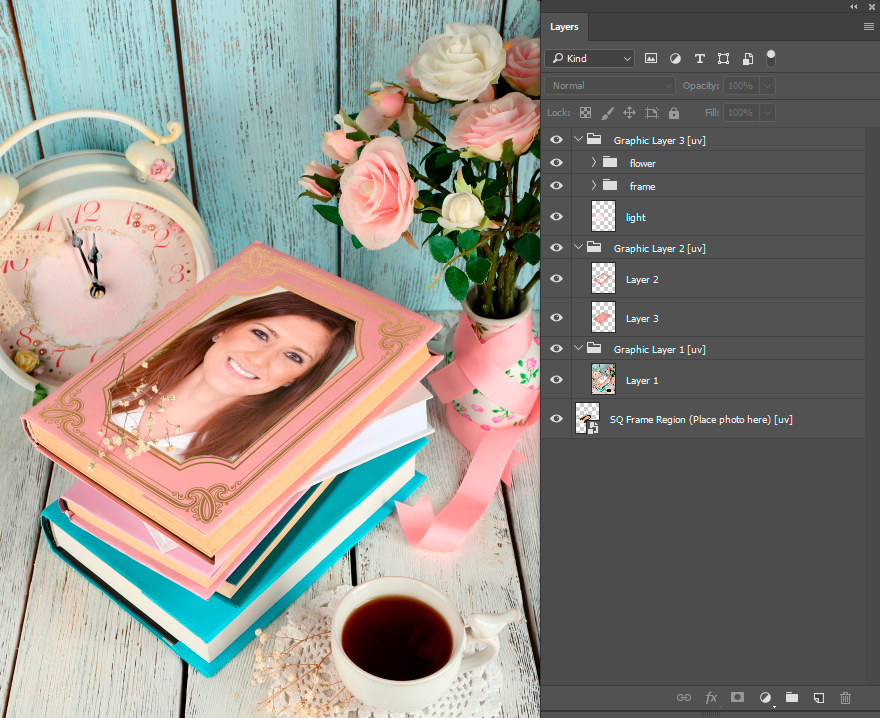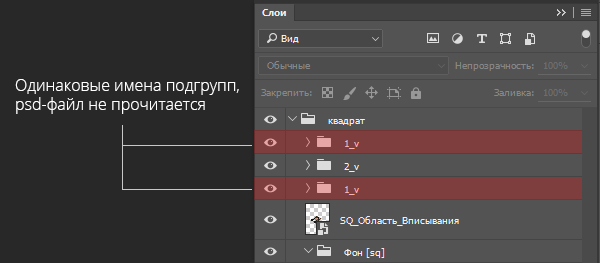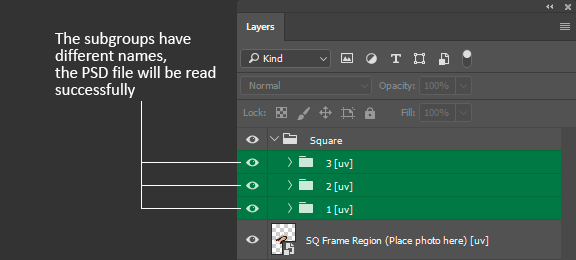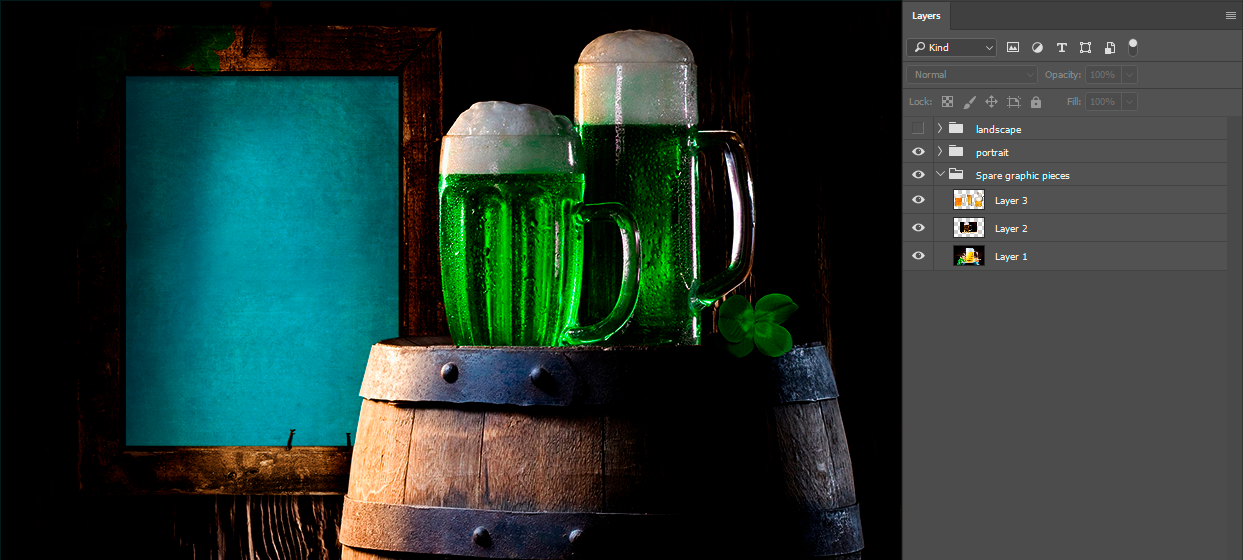Template structure in Photoshop
In order for a template PSD document to be correctly read by the Template Creator, it needs to have a certain structure in Photoshop.
A template structure is defined by:
- groups of layers
- subgroups of layers
- smart objects of user photo regions
Groups of layers
Groups of layers can be of 3 types: ‘portrait’, ‘landscape’ and ‘square’. The names of these groups should always correspond to their type: ‘portrait’, ‘landscape’ and ‘square’. It does not matter whether these names are capitalized or not.
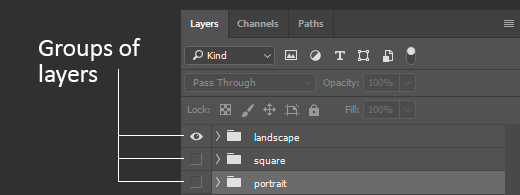
NB: As it appears from the names of the groups, each of them deals with a certain orientation of a template. I.e. each particular group stores layers and other elements adapted to a certain orientation of a user photo.
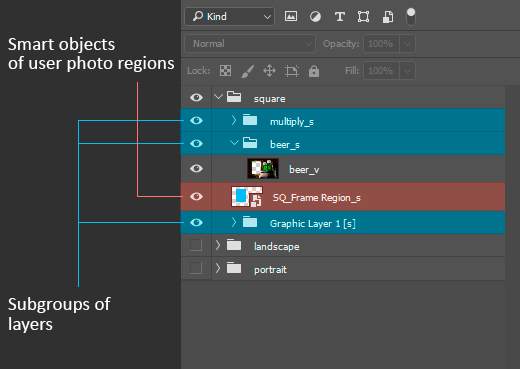
Below is an example of a template containing two types of layer groups (inside one PSD document). It is a “frame” template with “portrait” and “landscape” orientations:
| portrait | landscape |
|---|---|
A PSD document can contain 1, 2 or all 3 types of groups that define what types of user photos (portrait / landscape / square) the template is suited for.
A PSD document may also contain no groups dealing with a certain orientation. In this case all other template elements are positioned on the top level of the PSD file, and we say that this template has universal orientation.
СThere are also templates that contain several PSD documents, each of them storing a certain orientation. You need to store each orientation in a separate PSD document when canvases in different orientations have different aspect ratio.
Subgroups of layers
The next element in the PSD document structure is subgroups — of layers. A subgroup of layers consists of layers that have been grouped together, in terms of Photoshop.
Subgroups of layers contain graphic layers and other elements that are rasterized (‘merged’) into one layer on the level of this subgroup when the Template Creator reparses the PSD document.
In other words, everything placed into a subgroup of layers will appear as a, single layer in the Template Creator after reparsing. If there are blending modes and masks applied to graphic layers inside a subgroup, all of them will be rasterized on the level of this subgroup.
Blending modes and masks applied directly to subgroups of layers will be transferred to graphic layers generated by the Template Creator.
NB: As the contents of a subgroup will be merged into a single layer, the Pass Through blending mode cannot be processed correctly. Therefore, it is forbidden to apply this blending mode to subgroups of layers. Read more about the Pass Through blending mode here.
As for the layers arrangement in a PSD document, subgroups of layers can be positioned as follows:
- If a template contains different orientations, subgroups of layers are positioned directly in groups that define layer orientation.
- If a template has universal orientation, then subgroups of layers are positioned on the root level of a PSD document.
| Arrangement of subgroups of layers in a template with ‘square’ orientation | Arrangement of subgroups of layers in a template with universal orientation |
|---|---|
Important: stickers are a special case of subgroups of graphic layers. Subgroups of stickers are processed in a particular way.
User photo regions
A user photo region is an area where a user photo is placed. It is defined by a Smart Object in Photoshop. Depending on the type of a user photo region, its name should always start with one of the variants below:
- SQ — a prefix used for frame user photo regions.
- FSQ and FSQR — prefixes used for figure photo regions.
- Face region — a prefix used for face user photo regions.
Besides playing a major role in user photo positioning in a template, smart objects offer the following possibilities:
- You can store test user photos inside smart objects to try them with your template.
- All smart objects of the user photo region (except for face regions) can be transformed if your template needs it, but they must remain quadrangular (not necessarily rectangular, but you cannot use Distortion or Warp tools. If your template needs some distortion of the user photo region, learn about possibilities and restrictions regarding user photo region distortion here).
- You can apply masks and blending modes to smart objects (see the list of supported blending modes), as well as set their opacity.
User photo regions are positioned on the same level with the subgroups of graphic layers and can be arranged in any order relative to the subgroups of graphic layers and other user photo regions.
Important: the Template Creator won’t be able to read a PSD file, if it contains user photo regions, groups or subgroups of layers with identical names on the same level. For example, you cannot have two groups of layers called "Square", or two subgroups of layers with the same name (i.e. "1_v") in the "Square" layer group
If the Template Creator detects name coincidences in a PSD document, as mentioned above, it will prompt you to rename them automatically when reparsing the PSD file.

However, you can have layers with identical names within the subgroups.
|
The subgroups have identical names, the PSD file cannot be read |
The subgroups have different names, the PSD file will be read successfully |
|---|---|
Comparison of structure in Photoshop and in the Template Creator
The scheme below shows how template structure elements in Photoshop correspond to layers in the Template Creator.
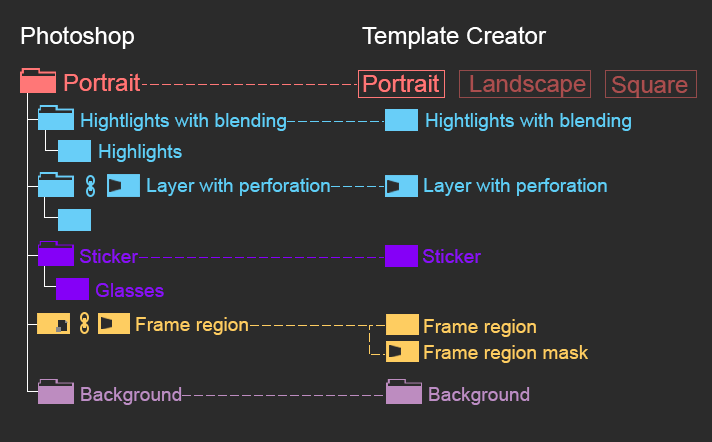
Important: when a user photo is processed with a template, the template is applied on top of a white background. If a template canvas is not fully covered by graphics (graphic layers, stickers and user photo regions) the white background will be visible through ‘gaps’.
Auxiliary materials
Auxiliary materials for creating a template (grids, etc.) can be inserted in two places:
- on the same level with the subgroups of layers (do not combine layers with these materials into groups). Layers can be called as you like (without the SQ prefix, so that the Template Creator does not confuse the service materials with the Smart Object of the Frame Region).
- on the top level (the same level with the Portrait/Landscape, etc. groups). Here the layers can be organized in groups with names other than "Portrait", "Landscape" and "Square".
| Storing auxiliary materials in a template supporting different orientations |
|---|
You are welcome to download samples of templates we’ve discussed above:
a template with several orientations can be downloaded here.
a template with universal orientation can be downloaded here.
a template with several orientations stored in different PSD documents can be downloaded here.


